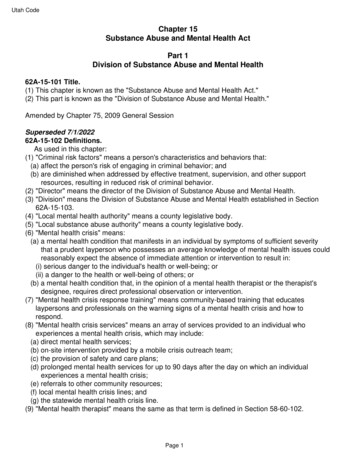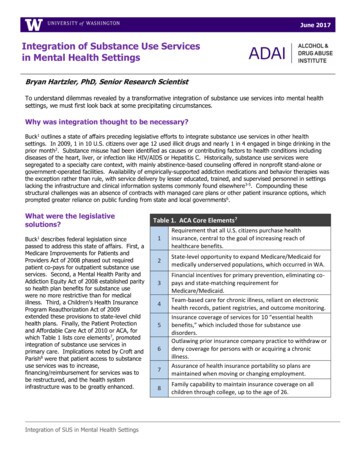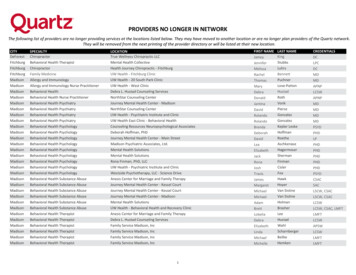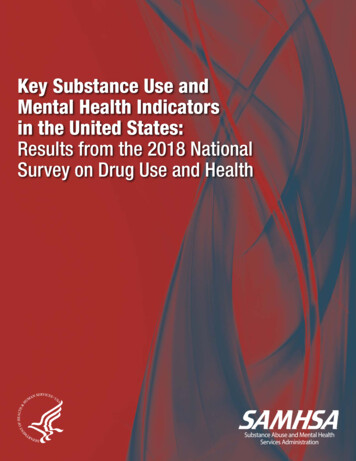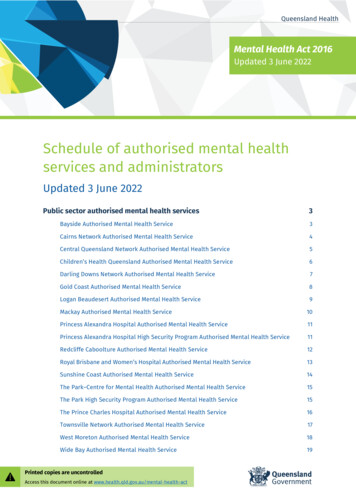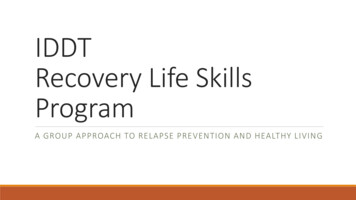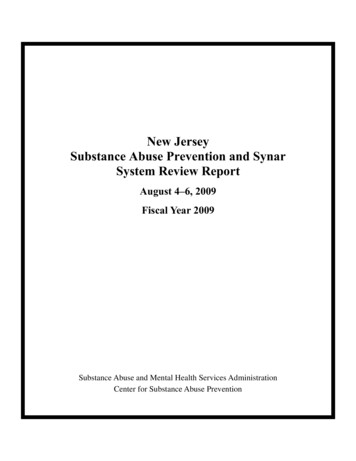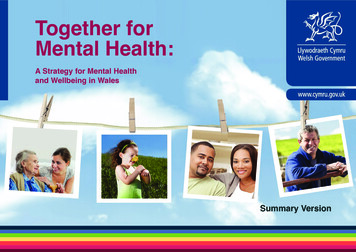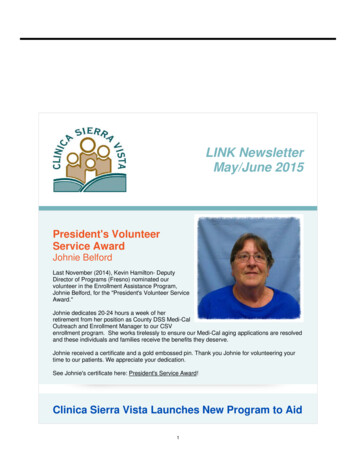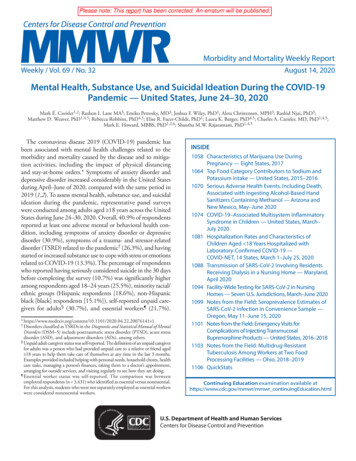
Transcription
Please note: This report has been corrected. An erratum will be published.Morbidity and Mortality Weekly ReportWeekly / Vol. 69 / No. 32August 14, 2020Mental Health, Substance Use, and Suicidal Ideation During the COVID-19Pandemic — United States, June 24–30, 2020Mark É. Czeisler1,2; Rashon I. Lane MA3; Emiko Petrosky, MD3; Joshua F. Wiley, PhD1; Aleta Christensen, MPH3; Rashid Njai, PhD3;Matthew D. Weaver, PhD1,4,5; Rebecca Robbins, PhD4,5; Elise R. Facer-Childs, PhD1; Laura K. Barger, PhD4,5; Charles A. Czeisler, MD, PhD1,4,5;Mark E. Howard, MBBS, PhD1,2,6; Shantha M.W. Rajaratnam, PhD1,4,5The coronavirus disease 2019 (COVID-19) pandemic hasbeen associated with mental health challenges related to themorbidity and mortality caused by the disease and to mitigation activities, including the impact of physical distancingand stay-at-home orders.* Symptoms of anxiety disorder anddepressive disorder increased considerably in the United Statesduring April–June of 2020, compared with the same period in2019 (1,2). To assess mental health, substance use, and suicidalideation during the pandemic, representative panel surveyswere conducted among adults aged 18 years across the UnitedStates during June 24–30, 2020. Overall, 40.9% of respondentsreported at least one adverse mental or behavioral health condition, including symptoms of anxiety disorder or depressivedisorder (30.9%), symptoms of a trauma- and stressor-relateddisorder (TSRD) related to the pandemic† (26.3%), and havingstarted or increased substance use to cope with stress or emotionsrelated to COVID-19 (13.3%). The percentage of respondentswho reported having seriously considered suicide in the 30 daysbefore completing the survey (10.7%) was significantly higheramong respondents aged 18–24 years (25.5%), minority racial/ethnic groups (Hispanic respondents [18.6%], non-Hispanicblack [black] respondents [15.1%]), self-reported unpaid caregivers for adults§ (30.7%), and essential workers¶ (21.7%).* .20076141v1.† Disorders classified as TSRDs in the Diagnostic and Statistical Manual of MentalDisorders (DSM–5) include posttraumatic stress disorder (PTSD), acute stressdisorder (ASD), and adjustment disorders (ADs), among others.§ Unpaid adult caregiver status was self-reported. The definition of an unpaid caregiverfor adults was a person who had provided unpaid care to a relative or friend aged 18 years to help them take care of themselves at any time in the last 3 months.Examples provided included helping with personal needs, household chores, healthcare tasks, managing a person’s finances, taking them to a doctor’s appointment,arranging for outside services, and visiting regularly to see how they are doing.¶ Essential worker status was self-reported. The comparison was betweenemployed respondents (n 3,431) who identified as essential versus nonessential.For this analysis, students who were not separately employed as essential workerswere considered nonessential workers.INSIDE1058 Characteristics of Marijuana Use DuringPregnancy — Eight States, 20171064 Top Food Category Contributors to Sodium andPotassium Intake — United States, 2015–20161070 Serious Adverse Health Events, Including Death,Associated with Ingesting Alcohol-Based HandSanitizers Containing Methanol — Arizona andNew Mexico, May–June 20201074 COVID-19–Associated Multisystem InflammatorySyndrome in Children — United States, March–July 20201081 Hospitalization Rates and Characteristics ofChildren Aged 18 Years Hospitalized withLaboratory-Confirmed COVID-19 —COVID-NET, 14 States, March 1–July 25, 20201088 Transmission of SARS-CoV-2 Involving ResidentsReceiving Dialysis in a Nursing Home — Maryland,April 20201094 Facility-Wide Testing for SARS-CoV-2 in NursingHomes — Seven U.S. Jurisdictions, March–June 20201099 Notes from the Field: Seroprevalence Estimates ofSARS-CoV-2 Infection in Convenience Sample —Oregon, May 11–June 15, 20201101 Notes from the Field: Emergency Visits forComplications of Injecting TransmucosalBuprenorphine Products — United States, 2016–20181103 Notes from the Field: Multidrug-ResistantTuberculosis Among Workers at Two FoodProcessing Facilities — Ohio, 2018–20191106 QuickStatsContinuing Education examination available athttps://www.cdc.gov/mmwr/mmwr continuingEducation.htmlU.S. Department of Health and Human ServicesCenters for Disease Control and Prevention
Morbidity and Mortality Weekly ReportCommunity-level intervention and prevention efforts, includinghealth communication strategies, designed to reach these groupscould help address various mental health conditions associatedwith the COVID-19 pandemic.During June 24–30, 2020, a total of 5,412 (54.7%) of9,896 eligible invited adults** completed web-based surveys††administered by Qualtrics.§§ The Monash University HumanResearch Ethics Committee of Monash University (Melbourne,Australia) reviewed and approved the study protocol on human** A minimum age of 18 years and residence within the United States as ofApril 2–8, 2020, were required for eligibility for the longitudinal cohort tocomplete a survey during June 24–30, 2020. Residence was reassessed duringJune 24–30, 2020, and one respondent who had moved from the United Stateswas excluded from the analysis. A minimum age of 18 years and residence withinthe United States were required for eligibility for newly recruited respondentsincluded in the cross-sectional analysis. For both the longitudinal cohort andnewly recruited respondents, respondents were required to provide informedconsent before enrollment into the study. All surveys underwent data qualityscreening procedures including algorithmic and keystroke analysis for attentionpatterns, click-through behavior, duplicate responses, machine responses, andinattentiveness. Country-specific geolocation verification via IP address mappingwas used to ensure respondents were from the United States. Respondents whofailed an attention or speed check, along with any responses identified by thedata-scrubbing algorithms, were excluded from analysis.†† The surveys contained 101 items for first-time respondents and 86 items forrespondents who also participated in later surveys, with the 15 additionalitems for first-time respondents consisting of questions on demographics. Thesurvey instruments included a combination of individual questions, validatedquestionnaires, and COVID-19-specific questionnaires, which were used toassess respondent attitudes, behaviors, and beliefs related to COVID-19 andits mitigation, as well as the social and behavioral health impacts of theCOVID-19 pandemic.§§ https://www.qualtrics.com/.subjects research. Respondents were informed of the study purposes and provided electronic consent before commencement,and investigators received anonymized responses. Participantsincluded 3,683 (68.1%) first-time respondents and 1,729(31.9%) respondents who had completed a related surveyduring April 2–8, May 5–12, 2020, or both intervals; 1,497(27.7%) respondents participated during all three intervals(2,3). Quota sampling and survey weighting were employedto improve cohort representativeness of the U.S. populationby gender, age, and race/ethnicity.¶¶ Symptoms of anxietydisorder and depressive disorder were assessed using the fouritem Patient Health Questionnaire*** (4), and symptoms ofa COVID-19–related TSRD were assessed using the six-itemImpact of Event Scale††† (5). Respondents also reported¶¶Survey weighting was implemented according to the 2010 U.S. Census withrespondents who reported gender, age, and race/ethnicity. Respondents whoreported a gender of “Other,” or who did not report race/ethnicity wereassigned a weight of one.*** Symptoms of anxiety disorder and depressive disorder were assessed via thefour-item Patient Health Questionnaire (PHQ-4). Those who scored 3 outof 6 on the Generalized Anxiety Disorder (GAD-2) and Patient HealthQuestionnaire (PHQ-2) subscales were considered symptomatic for theserespective disorders. This instrument was included in the April, May, andJune surveys.††† Symptoms of a TSRD attributed to the COVID-19 pandemic were assessedvia the six-item Impact of Event Scale (IES-6) to screen for overlappingsymptoms of PTSD, ASD, and ADs. For this survey, the COVID-19 pandemicwas specified as the traumatic exposure to record peri- and posttraumaticsymptoms associated with the range of stressors introduced by the COVID-19pandemic. Those who scored 1.75 out of 4 were considered symptomatic.This instrument was included in the May and June surveys only.The MMWR series of publications is published by the Center for Surveillance, Epidemiology, and Laboratory Services, Centers for Disease Control and Prevention (CDC),U.S. Department of Health and Human Services, Atlanta, GA 30329-4027.Suggested citation: [Author names; first three, then et al., if more than six.] [Report title]. MMWR Morb Mortal Wkly Rep 2020;69:[inclusive page numbers].Centers for Disease Control and PreventionRobert R. Redfield, MD, DirectorAnne Schuchat, MD, Principal Deputy DirectorChesley L. Richards, MD, MPH, Deputy Director for Public Health Science and SurveillanceRebecca Bunnell, PhD, MEd, Director, Office of ScienceArlene Greenspan, PhD, Acting Director, Office of Science Quality, Office of ScienceMichael F. Iademarco, MD, MPH, Director, Center for Surveillance, Epidemiology, and Laboratory ServicesMMWR Editorial and Production Staff (Weekly)Charlotte K. Kent, PhD, MPH, Editor in ChiefJacqueline Gindler, MD, EditorPaul Z. Siegel, MD, MPH, Guest Associate EditorMary Dott, MD, MPH, Online EditorTerisa F. Rutledge, Managing EditorDouglas W. Weatherwax, Lead Technical Writer-EditorGlenn Damon, Soumya Dunworth, PhD,Teresa M. Hood, MS, Donald G. Meadows, MATechnical Writer-EditorsMichelle E. Bonds, MBAMatthew L. Boulton, MD, MPHCarolyn Brooks, ScD, MAJay C. Butler, MDVirginia A. Caine, MD1050Martha F. Boyd, Lead Visual Information SpecialistMaureen A. Leahy, Julia C. Martinroe,Stephen R. Spriggs, Tong Yang,Visual Information SpecialistsQuang M. Doan, MBA, Phyllis H. King,Terraye M. Starr, Moua Yang,Information Technology SpecialistsMMWR Editorial BoardTimothy F. Jones, MD, ChairmanKatherine Lyon Daniel, PhDJonathan E. Fielding, MD, MPH, MBADavid W. Fleming, MDWilliam E. Halperin, MD, DrPH, MPHJewel Mullen, MD, MPH, MPAJeff Niederdeppe, PhDMMWR / August 14, 2020 / Vol. 69 / No. 32Patricia Quinlisk, MD, MPHPatrick L. Remington, MD, MPHCarlos Roig, MS, MAWilliam Schaffner, MDMorgan Bobb Swanson, BSUS Department of Health and Human Services/Centers for Disease Control and Prevention
Morbidity and Mortality Weekly Reportwhether they had started or increased substance use to copewith stress or emotions related to COVID-19 or seriouslyconsidered suicide in the 30 days preceding the survey.§§§Analyses were stratified by gender, age, race/ethnicity,employment status, essential worker status, unpaid adult caregiver status, rural-urban residence classification,¶¶¶ whetherthe respondent knew someone who had positive test resultsfor SARS-CoV-2, the virus that causes COVID-19, or whohad died from COVID-19, and whether the respondent wasreceiving treatment for diagnosed anxiety, depression, or posttraumatic stress disorder (PTSD) at the time of the survey.Comparisons within subgroups were evaluated using Poissonregressions with robust standard errors to calculate prevalenceratios, 95% confidence intervals (CIs), and p-values to evaluatestatistical significance (a 0.005 to account for multiple comparisons). Among the 1,497 respondents who completed allthree surveys, longitudinal analyses of the odds of incidence****of symptoms of adverse mental or behavioral health conditionsby essential worker and unpaid adult caregiver status wereconducted on unweighted responses using logistic regressionsto calculate unadjusted and adjusted†††† odds ratios (ORs),95% CI, and p-values (a 0.05). The statsmodels packagein Python (version 3.7.8; Python Software Foundation) wasused to conduct all analyses.Overall, 40.9% of 5,470 respondents who completed surveysduring June reported an adverse mental or behavioral healthcondition, including those who reported symptoms of anxietydisorder or depressive disorder (30.9%), those with TSRD symptoms related to COVID-19 (26.3%), those who reported having§§§For this survey, substance use was defined as use of “alcohol, legal or illegaldrugs, or prescriptions drugs that are taken in a way not recommended byyour doctor.” Questions regarding substance use and suicidal ideation wereincluded in the May and June surveys only. Participants were informedthat responses were deidentified and that direct support could not beprovided to those who reported substance use behavior or suicidal ideation.Regarding substance use, respondents were provided the following: “Thissurvey is anonymous so we cannot provide direct support. If you wouldlike crisis support please contact the Substance Abuse and Mental HealthServices Administration National Helpline, 1-800-662-HELP (4357), (alsoknown as the Treatment Referral Routing Service) or TTY: 1-800-487-4889.This is a confidential, free, 24-hour-a-day, 365-day-a-year, informationservice, in English and Spanish, for persons and family members facingmental and/or substance use disorders.” Regarding suicidal ideation,respondents were provided the following: “This survey is anonymous sowe cannot provide direct support. If you would like crisis support pleasecontact the National Suicide Prevention Lifeline, 1-800-273-TALK (8255,or chat line) for help for themselves or others.”¶¶¶ Rural-urban classification was determined by using self-reported ZIP codesaccording to the Federal Office of Rural Health Policy definition of s/definition/datafiles.html.**** Odds of incidence was defined as the odds of the presence of an adversemental or behavioral health outcome reported during a later survey afterpreviously having reported the absence of that outcome (e.g., havingreported symptoms of anxiety disorder during June 24–30, 2020, after nothaving reported symptoms of anxiety disorder during April 2–8, 2020).†††† Adjusted for gender, employment status, and essential worker status orunpaid adult caregiver status.started or increased substance use to cope with stress or emotionsrelated to COVID-19 (13.3%), and those who reported havingseriously considered suicide in the preceding 30 days (10.7%)(Table 1). At least one adverse mental or behavioral healthsymptom was reported by more than one half of respondentswho were aged 18–24 years (74.9%) and 25–44 years (51.9%),of Hispanic ethnicity (52.1%), and who held less than a highschool diploma (66.2%), as well as those who were essentialworkers (54.0%), unpaid caregivers for adults (66.6%), and whoreported treatment for diagnosed anxiety (72.7%), depression(68.8%), or PTSD (88.0%) at the time of the survey.Prevalences of symptoms of adverse mental or behavioralhealth conditions varied significantly among subgroups(Table 2). Suicidal ideation was more prevalent among malesthan among females. Symptoms of anxiety disorder or depressivedisorder, COVID-19–related TSRD, initiation of or increasein substance use to cope with COVID-19–associated stress,and serious suicidal ideation in the previous 30 days were mostcommonly reported by persons aged 18–24 years; prevalencedecreased progressively with age. Hispanic respondents reportedhigher prevalences of symptoms of anxiety disorder or depressivedisorder, COVID-19–related TSRD, increased substance use,and suicidal ideation than did non-Hispanic whites (whites) ornon-Hispanic Asian (Asian) respondents. Black respondentsreported increased substance use and past 30-day serious consideration of suicide in the previous 30 days more commonly thandid white and Asian respondents. Respondents who reportedtreatment for diagnosed anxiety, depression, or PTSD at thetime of the survey reported higher prevalences of symptomsof adverse mental and behavioral health conditions comparedwith those who did not. Symptoms of a COVID-19–relatedTSRD, increased substance use, and suicidal ideation were moreprevalent among employed than unemployed respondents, andamong essential workers than nonessential workers. Adverseconditions also were more prevalent among unpaid caregivers foradults than among those who were not, with particularly largedifferences in increased substance use (32.9% versus 6.3%) andsuicidal ideation (30.7% versus 3.6%) in this group.Longitudinal analysis of responses of 1,497 persons who completed all three surveys revealed that unpaid caregivers for adultshad a significantly higher odds of incidence of adverse mentalhealth conditions compared with others (Table 3). Among thosewho did not report having started or increased substance use tocope with stress or emotions related to COVID-19 in May, unpaidcaregivers for adults had 3.33 times the odds of reporting thisbehavior in June (adjusted OR 95% CI 1.75–6.31; p 0.001).Similarly, among those who did not report having seriously considered suicide in the previous 30 days in May, unpaid caregiversfor adults had 3.03 times the odds of reporting suicidal ideationin June (adjusted OR 95% CI 1.20–7.63; p 0.019).US Department of Health and Human Services/Centers for Disease Control and PreventionMMWR / August 14, 2020 / Vol. 69 / No. 321051
Morbidity and Mortality Weekly ReportTABLE 1. Respondent characteristics and prevalence of adverse mental health outcomes, increased substance use to cope with stress oremotions related to COVID-19 pandemic, and suicidal ideation — United States, June 24–30, 2020Weighted %*CharacteristicAll respondentswho completedsurveys duringJune 24–30, 2020weighted* no. (%)All respondents5,470 (100)GenderFemale2,784 (50.9)Male2,676 (48.9)Other10 (0.2)Age group (yrs)18–24731 (13.4)25–441,911 (34.9)45–641,895 (34.6) 65933 (17.1)Race/EthnicityWhite,3,453 (63.1)non-HispanicBlack,663 (12.1)non-HispanicAsian,256 (4.7)non-HispanicOther race or164 (3.0)multiple races,non-Hispanic**Hispanic, any885 (16.2)race(s)Unknown50 (0.9)2019 Household income (USD) 25,000741 (13.6)25,000–49,9991,123 (20.5)50,999–99,9991,775 (32.5)100,999–199,9991,301 (23.8) 200,000282 (5.2)Unknown247 (4.5)EducationLess than high78 (1.4)school diplomaHigh school943 (17.2)diplomaSome college1,455 (26.6)Bachelor’s degree1,888 (34.5)Professional1,074 (19.6)degreeUnknown33 (0.6)Employment status††Employed3,431 (62.7)Essential1,785 (32.6)Nonessential1,646 (30.1)Unemployed761 (13.9)Retired1,278 (23.4)Unpaid adult caregiver status§§Yes1,435 (26.2)No4,035 (73.8)Region¶¶Northeast1,193 (21.8)Midwest1,015 (18.6)South1,921 (35.1)West1,340 (24.5)Rural-urban classification***Rural599 (10.9)Urban4,871 (89.1)See table footnotes on the next page.1052ConditionsCOVID-19–related TSRD§Started or increasedsubstance useto cope withpandemic-related stressor 324.720.0MMWR / August 14, 2020 / Vol. 69 / No. 32Anxiety ordepressivedisorder† 1 adverseSeriouslymental orconsidered behavioralsuicide inhealthpast 30 days symptomUS Department of Health and Human Services/Centers for Disease Control and Prevention
Morbidity and Mortality Weekly ReportTABLE 1. (Continued) Respondent characteristics and prevalence of adverse mental health outcomes, increased substance use to cope withstress or emotions related to COVID-19 pandemic, and suicidal ideation — United States, June 24–30, 2020Weighted %*CharacteristicAll respondentswho completedsurveys duringJune 24–30, 2020weighted* no. ��COVID-19–related xiety ordepressivedisorder†Know someone who had positive test results for SARS-CoV-2Yes1,109 (20.3)23.821.9No4,361 (79.7)26.025.0Knew someone who died from COVID-19Yes428 (7.8)25.820.6No5,042 (92.2)25.524.7Receiving treatment for previously diagnosed conditionAnxietyYes536 (9.8)59.652.0No4,934 (90.2)21.821.3DepressionYes540 (9.9)52.550.6No4,930 (90.1)22.621.5Posttraumatic stress disorderYes251 (4.6)72.369.1No5,219 (95.4)23.322.2 1 adverseSeriouslymental orconsidered behavioralsuicide inhealthpast 30 days symptomStarted or increasedsubstance useto cope withpandemic-related stressor emotions¶Abbreviations: COVID-19 coronavirus disease 2019; TSRD trauma- or stress-related disorder.* Survey weighting was employed to improve the cross-sectional June cohort representativeness of the U.S. population by gender, age, and race/ethnicity accordingto the 2010 U.S. Census with respondents in which gender, age, and race/ethnicity were reported. Respondents who reported a gender of “Other” or who did notreport race/ethnicity were assigned a weight of one.† Symptoms of anxiety disorder and depressive disorder were assessed via the four-item Patient Health Questionnaire (PHQ-4). Those who scored 3 out of 6 onthe Generalized Anxiety Disorder (GAD-2) and Patient Health Questionnaire (PHQ-2) subscales were considered symptomatic for each disorder, respectively.§ Disorders classified as TSRDs in the Diagnostic and Statistical Manual of Mental Disorders (DSM–5) include posttraumatic stress disorder (PTSD), acute stress disorder(ASD), and adjustment disorders (ADs), among others. Symptoms of a TSRD precipitated by the COVID-19 pandemic were assessed via the six-item Impact of EventScale (IES-6) to screen for overlapping symptoms of PTSD, ASD, and ADs. For this survey, the COVID-19 pandemic was specified as the traumatic exposure to recordperi- and posttraumatic symptoms associated with the range of stressors introduced by the COVID-19 pandemic. Those who scored 1.75 out of 4 wereconsidered symptomatic.¶ 104 respondents selected “Prefer not to answer.”** The Other race or multiple races, non-Hispanic category includes respondents who identified as not being Hispanic and as more than one race or as American Indianor Alaska Native, Native Hawaiian or Pacific Islander, or “Other.”†† Essential worker status was self-reported. The comparison was between employed respondents (n 3,431) who identified as essential vs. nonessential. For thisanalysis, students who were not separately employed as essential workers were considered nonessential workers.§§ Unpaid adult caregiver status was self-reported. The definition of an unpaid caregiver for adults was a person who had provided unpaid care to a relative or friendaged 18 years to help them take care of themselves at any time in the last three months. Examples provided included helping with personal needs, householdchores, health care tasks, managing a person’s finances, taking them to a doctor’s appointment, arranging for outside services, and visiting regularly to see howthey are doing.¶¶ Region classification was determined by using the U.S. Census Bureau’s Census Regions and Divisions of the United States. ference/us regdiv.pdf.*** Rural-urban classification was determined by using self-reported ZIP codes according to the Federal Office of Rural Health Policy definition of rurality. ion/datafiles.html.DiscussionElevated levels of adverse mental health conditions, substanceuse, and suicidal ideation were reported by adults in the UnitedStates in June 2020. The prevalence of symptoms of anxietydisorder was approximately three times those reported in thesecond quarter of 2019 (25.5% versus 8.1%), and prevalence ofdepressive disorder was approximately four times that reported inthe second quarter of 2019 (24.3% versus 6.5%) (2). However,given the methodological differences and potential unknownbiases in survey designs, this analysis might not be directlycomparable with data reported on anxiety and depression disorders in 2019 (2). Approximately one quarter of respondentsreported symptoms of a TSRD related to the pandemic, andapproximately one in 10 reported that they started or increasedsubstance use because of COVID-19. Suicidal ideation was alsoelevated; approximately twice as many respondents reportedserious consideration of suicide in the previous 30 days than didadults in the United States in 2018, referring to the previous12 months (10.7% versus 4.3%) (6).Mental health conditions are disproportionately affectingspecific populations, especially young adults, Hispanic persons, black persons, essential workers, unpaid caregivers foradults, and those receiving treatment for preexisting psychiatricconditions. Unpaid caregivers for adults, many of whom arecurrently providing critical aid to persons at increased riskUS Department of Health and Human Services/Centers for Disease Control and PreventionMMWR / August 14, 2020 / Vol. 69 / No. 321053
Morbidity and Mortality Weekly ReportTABLE 2. Comparison of symptoms of adverse mental health outcomes among all respondents who completed surveys (N 5,470), by respondentcharacteristic* — United States, June 24–30, 2020Prevalence ratio¶ (95% CI¶)CharacteristicGenderFemale vs. maleAge group (yrs)18–24 vs. 25–4418–24 vs. 45–6418–24 vs. 6525–44 vs. 45–6425–44 vs. 6545–64 vs. 65Race/Ethnicity††Hispanic vs. non-Hispanic blackHispanic vs. non-Hispanic AsianHispanic vs. non-Hispanic other raceor multiple racesHispanic vs. non-Hispanic whiteNon-Hispanic black vs.non-Hispanic AsianNon-Hispanic black vs. non-Hispanicother race or multiple racesNon-Hispanic black vs.non-Hispanic whiteNon-Hispanic Asian vs. non-Hispanicother race or multiple racesNon-Hispanic Asian vs.non-Hispanic whiteNon-Hispanic other race or multipleraces vs. non-Hispanic whiteSee table footnotes on the next page.Symptoms of anxietydisorder or depressivedisorder†Symptoms of a TSRDrelated to COVID-19§Started or increased substance useto cope with stress or emotionsrelated to COVID-19Serious considerationof suicide in past 30 days1.04 (0.96–1.12)0.88 (0.81–0.97)0.85 (0.75–0.98)0.70 (0.60–0.82)**1.56 (1.44–1.68)**3.10 (2.79–3.44)**7.73 (6.19–9.66)**1.99 (1.79–2.21)**4.96 (3.97–6.20)**2.49 (1.98–3.15)**1.28 (1.16–1.41)**2.67 (2.35–3.03)**5.01 (4.04–6.22)**2.09 (1.86–2.35)**3.93 (3.18–4.85)**1.88 (1.50–2.35)**1.31 (1.12–1.53)**3.35 (2.75–4.10)**8.77 (5.95–12.93)**2.56 (2.14–3.07)**6.70 (4.59–9.78)**2.62 (1.76–3.9)**1.59 (1.35–1.87)**6.66 (5.15–8.61)**12.51 (7.88–19.86)**4.18 (3.26–5.36)**7.86 (4.98–12.41)**1.88 (1.14–3.10)1.35 (1.18–1.56)**2.27 (1.73–2.98)**1.23 (0.98–1.55)1.15 (1.00–1.33)1.59 (1.24–2.04)**1.24 (0.96–1.61)1.19 (0.97–1.46)3.29 (2.05–5.28)**1.99 (1.27–3.13)**1.23 (0.98–1.55)2.82 (1.74–4.57)**1.89 (1.16–3.06)1.40 (1.27–1.54)**1.68 (1.26–2.23)**1.50 (1.35–1.68)**1.38 (1.07–1.78)2.09 (1.79–2.45)**2.75 (1.70–4.47)**2.35 (1.96–2.80)**2.29 (1.39–3.76)**0.91 (0.71–1.16)1.08 (0.82–1.41)1.67 (1.05–2.65)1.53 (0.93–2.52)1.03 (0.91–1.17)1.30 (1.14–1.48)**1.75 (1.45–2.11)**1.90 (1.54–2.36)**0.54 (0.39–0.76)**0.78 (0.56–1.09)0.61 (0.32–1.14)0.67 (0.35–1.29)0.62 (0.47–0.80)**0.95 (0.74–1.20)0.64 (0.40–1.02)0.83 (0.52–1.34)1.14 (0.91–1.42)1.21 (0.94–1.56)1.05 (0.67–1.64)1.24 (0.77–2)for severe illness from COVID-19, had a higher incidence ofadverse mental and behavioral health conditions comparedwith others. Although unpaid caregivers of children were notevaluated in this study, approximately 39% of unpaid caregiversfor adults shared a household with children (compared with27% of other respondents). Caregiver workload, especially inmultigenerational caregivers, should be considered for futureassessment of mental health, given the findings of this reportand hardships potentially faced by caregivers.The findings in this report are subject to at least four limitations. First, a diagnostic evaluation for anxiety disorder ordepressive disorder was not conducted; however, clinicallyvalidated screening instruments were used to assess symptoms.Second, the trauma- and stressor-related symptoms assessedwere common to multiple TSRDs, precluding distinctionamong them; however, the findings highlight the importance of including COVID-19–specific trauma measuresto gain insights into peri- and posttraumatic impacts of theCOVID-19 pandemic (7). Third, substance use behaviorwas self-reported; therefore, responses might be subject torecall, response, and social desirability biases. Finally, giventhat the web-based survey might not be fully representativeof the United States population, findings might have limited1054MMWR / August 14, 2020 / Vol. 69 / No. 32generalizability. However, standardized quality and data inclusion screening procedures, including algorithmic analysis ofclick-through behavior, removal of duplicate responses andscrubbing methods for web-based panel quality were applied.Further the prevalence of symptoms of anxiety disorder anddepressive disorder were largely consistent with findings fromthe Ho
Impact of Event Scale ††† (5). Respondents also reported . S¶¶ urvey weighting was implemented according to the 2010 U.S. Census with respondents who reported gender, age, and race/ethnicity. Respondents who . reported a gender of "Other," or who did not report race/ethnicity were assigned a weight of one.
